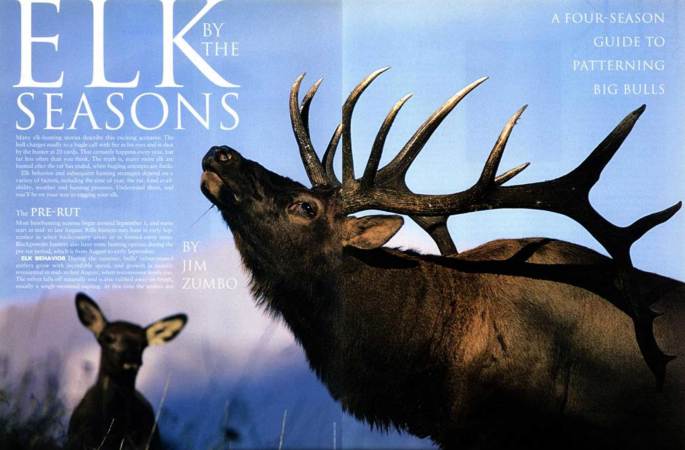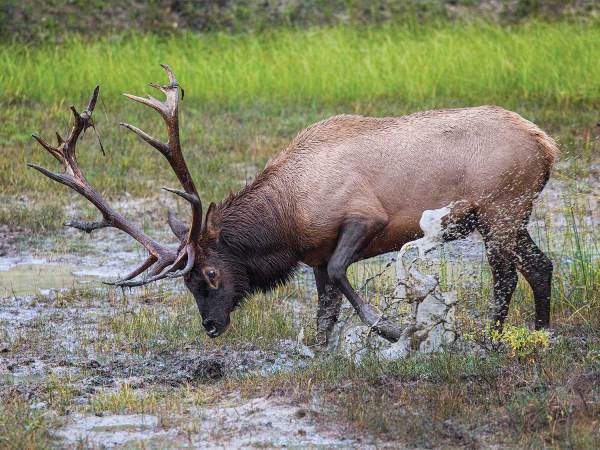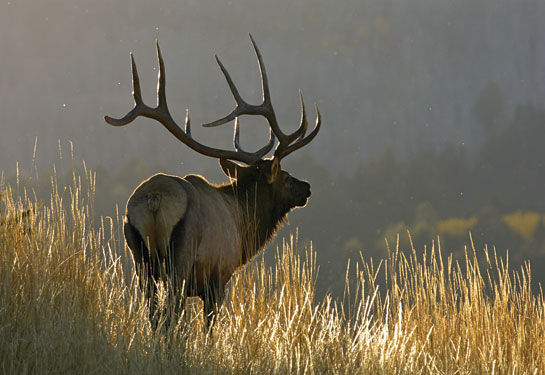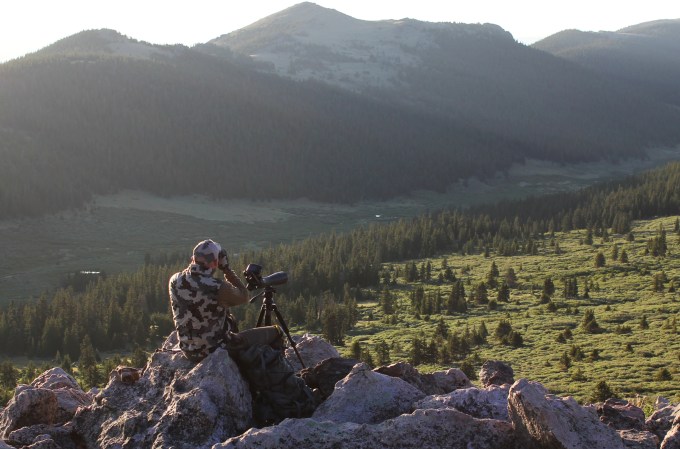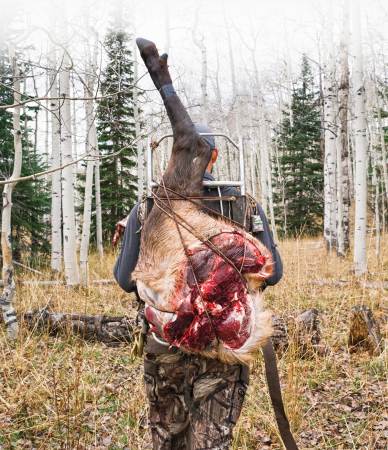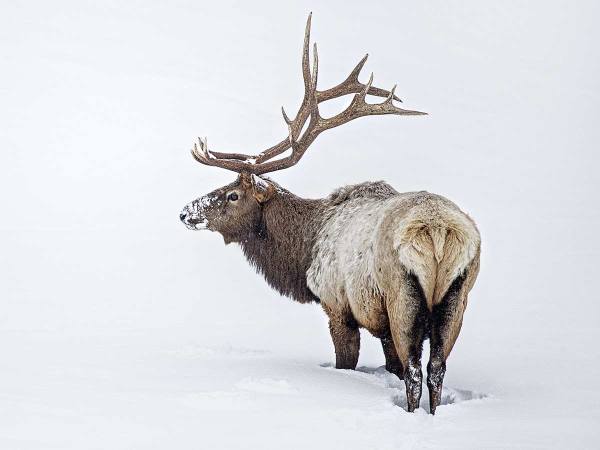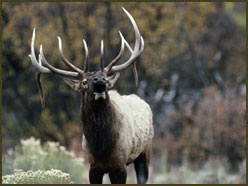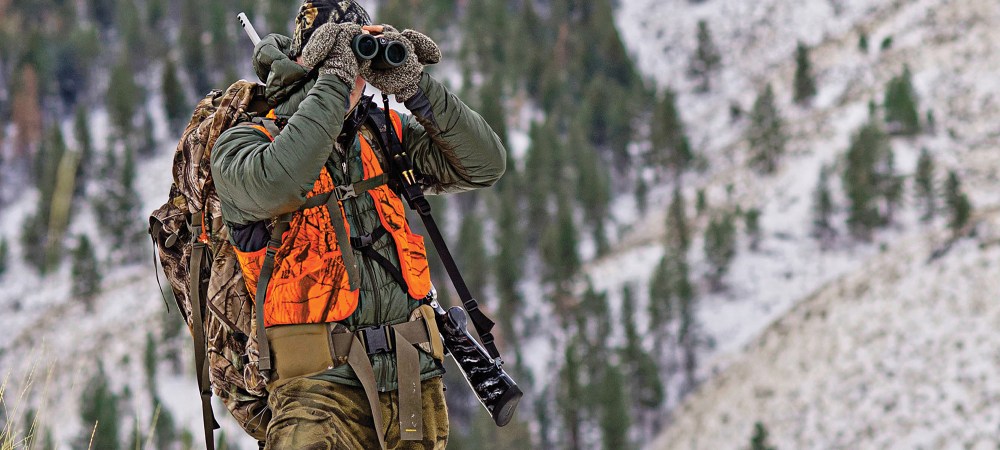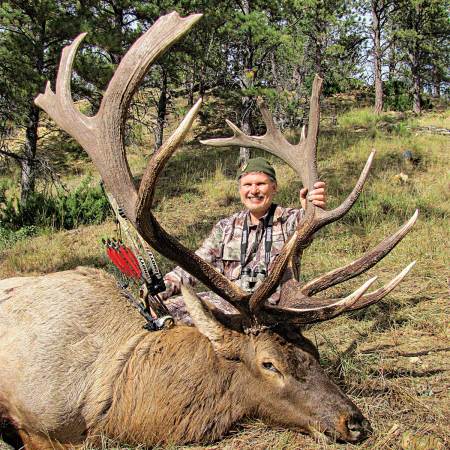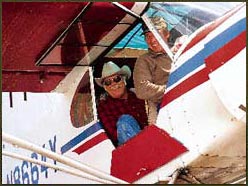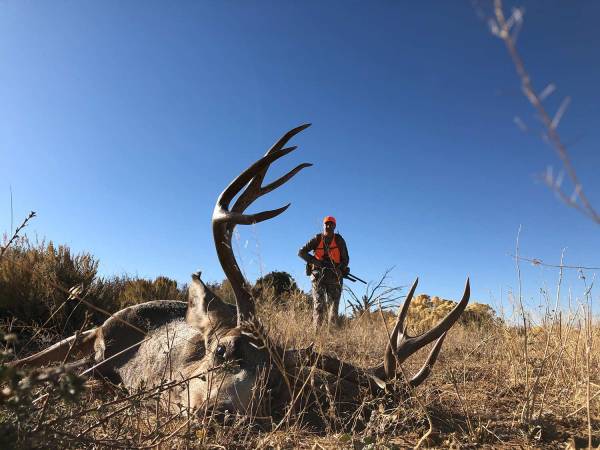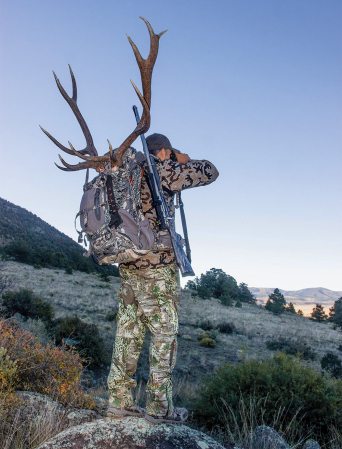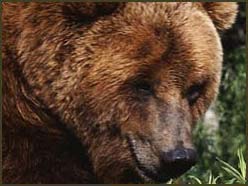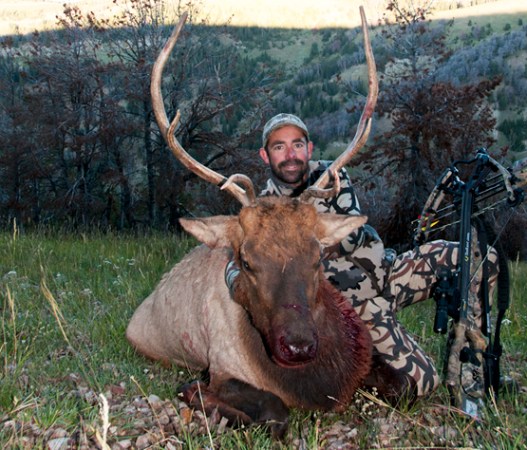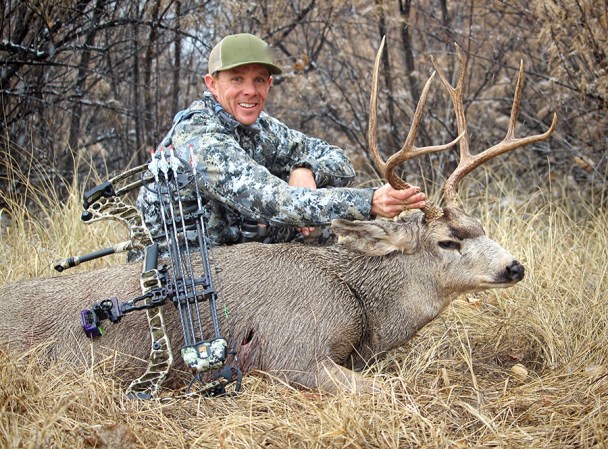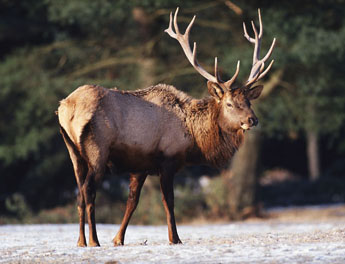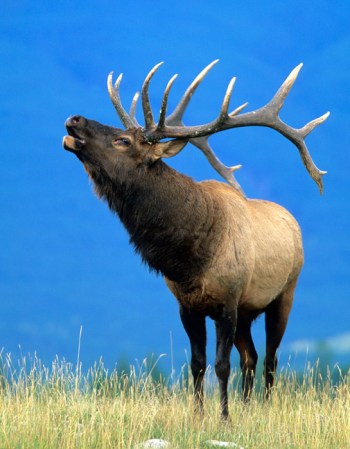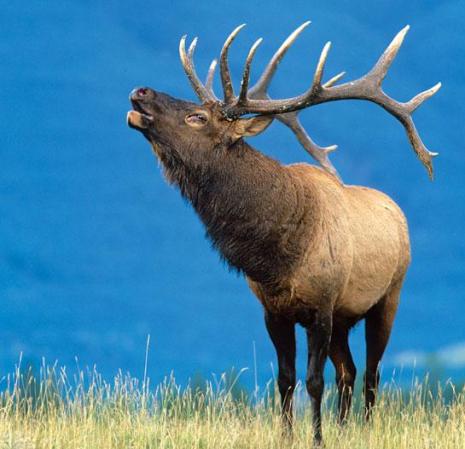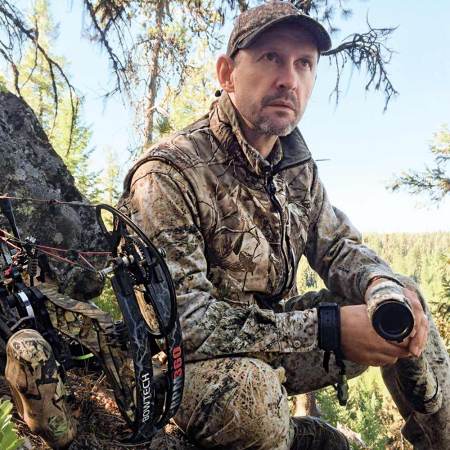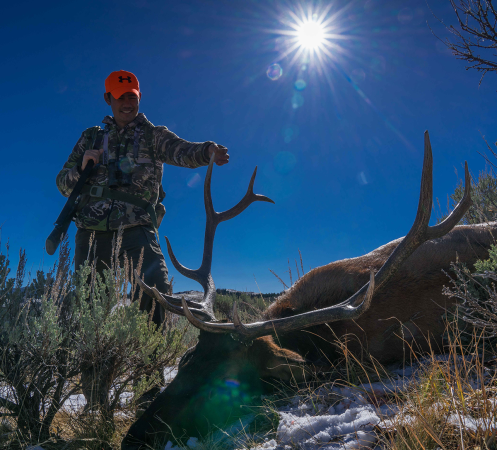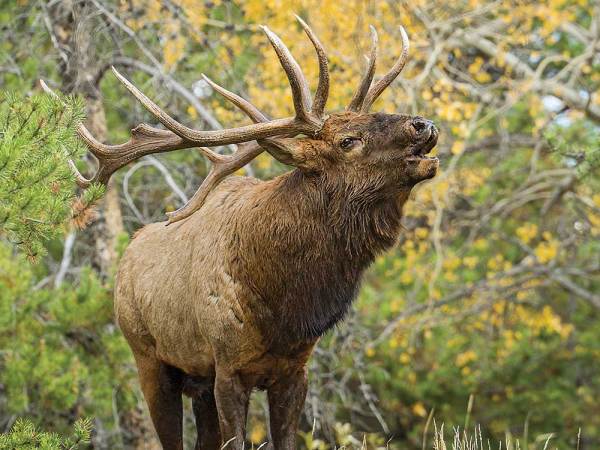Take advantage ofthe weather, the terrain and other hunters to tag your bull
1 You’re in unfamiliar country and have no clue where to hunt. It’s public land with plenty of hunters, and the rut is over. Where do you look?
This scenario is the reason 75 percent of all hunters go home with unpunched elk tags. Calling with a bugle isn’t an effective option during the general seasons, which typically run from mid-October into November. Hunters who are consistently successful have one thing in common: They aren’t afraid to penetrate the forest and climb the mountains, doing whatever it takes to find elk. How far to hike? You can easily walk 7 to 10 miles a day if you take your time and move along, looking for sign as you go.
SEEK SECURE COVER: Locate security terrain that elk use to evade hunters. I’ve found that animals will go to the densest cover they can find when hunting pressure is heavy. Locate a spruce-fir blowdown in an old-age forest and you’re in business. Never mind that it seems no elk could possibly negotiate the heavy thickets–they can and will.
MAKE NOISE: The obvious question is how to hunt noisy cover, since every elk within hearing range will detect your presence as you thrash through the brush. By the way, you should be making noise. If you’re not, you’re either in an open forest or on a trail or old road, which are places that elk avoid. Try this: Blow a cow call every couple of minutes as you work through brush. Elk within earshot will be reassured that you’re not danger. If they finally spot you, blow the cow call as hard as you can. Most elk will stop in their tracks for a few seconds, giving you an opportunity for a standing shot.
HIKE STEEP TERRAIN: Here’s another option to find elk in high-pressure areas. Most hunters don’t like to descend into steep, timbered canyons because they have to climb back out, and transporting an elk uphill can be a nightmare. The absence of hunters is the reason you should hunt there. Elk will hole up in those nasty, undisturbed draws.
Choose a canyon that has no roads or main trails in the bottom. You’re most apt to find elk in the thickest stands of timber, and don’t be concerned about steep grades. Elk are very much at home in severe terrain. Check the wind as you work your way down. In the daytime, mountain thermals blow uphill. Keep the cow call handy to stop spooked elk.
2 Again, you’re hunting elk in a place that gets a lot of public pressure, but you aren’t physically able to hunt rugged country.
In this case, you must hunt smarter. Let the other hunters work for you. You might be amazed at the crowds of people in popular elk country with good access on public land. I once counted 72 camps along a two-mile stretch of public road on a national forest in Colorado. How should you deal with a situation like that? Keep in mind that those hunters are there because elk are around. Your challenge is to tag one before the next person does.
A TYPICAL OPENING-MORNING SCENARIO: Prior to legal shooting hours, most hunters will be headed out. They’ll be driving trucks or roaring around on ATVs and alerting every elk within miles. Spooked elk don’t have a magical place to hide. They’ll head out of the meadows where they’ve been feeding all night long and be in the timber well before daylight. They may run for miles in the timber, stopping here and there, but they’ll always be on the go as hunters push into their otherwise safe havens.
WORK RIDGES: Since you can’t travel easily, work your way out on a ridge in the dark long before hunters begin stirring. Ideally, you’ll have scouted out a spot the day before and marked the trail so you can find it again. Your vantage point should offer enough elevation from which to look down into slopes below you. The idea is to plant yourself there and remain as long as you can–all day, if possible. By setting up long before other hunters are active, you’ll be in the catbird seat when people begin pushing elk. And by keeping stationary, you’ll have a great view of everything that goes on below you. Bring your lunch with you and resist the urge to go back to camp at midday. Nap where you sit if necessary. Bear in mind that you don’t have to walk miles to a spot. Even a quarter mile is good. I’ve seen elk cross roads in front of camps, and even run through camps in full daylight.
If you aren’t patient enough to sit, find a place where your pals can drop you off on a ridge where there’s a road in the bottom below the slopes you intend to hunt. The idea is for you to work your way slowly downhill and be picked up on the road in the bottom by your pals at a prescribed time. Move at a pace you’re comfortable with, and stop at overlooks frequently where you can watch for elk. Hunt with a companion if you’re not willing to try this solo.
What happens if you shoot an elk and you’re alone, or you and your pal can’t deal with it? Carry a two-way radio so you can communicate with other hunters in your party. You might even be able to get a signal on your cell phone. There’s nothing wrong with using electronic communication to ask for assistance after downing an elk; in my mind there’s plenty wrong with using it to guide hunters to game.
3 It’s the early September pre-rut. Elk have lockjaw and haven’t made a peep in days.
During this time many bulls shed their velvet and break out of their bachelor herds. They begin to travel to locate bands of cows and calves and will be minimally vocal, if at all.
HUNT RUBS: Rubbing antlers on saplings is a big part of a bull’s daily activity. They do this to mark territory and display dominance. High rubs on large saplings denote mature bulls. The rubbing activity is often done with no vocalization. Cover as much country as you can, looking for fresh rubs. If you find an unusually large number, slow down and be alert. If you found the spot during the heat of the day, consider slowly backing off and returning later in the afternoon or early in the morning when bulls are active. Blow a cow call softly every five minutes or so and remain alert.
LOCATE WALLOWS: Elk also use wallows in the heat of late summer. Bulls will typically visit a wallow every day, roll around in the mud, urinate profusely, and leave with mud caked on their hides. This behavior is usually done in late afternoon, if at all during daylight hours. If you locate a fresh wallow, investigate the area and look intently for a trail that animals use. Hunt from a spot where the wind will be favorable when you anticipate visits from elk.
To locate wallows, check the edges of meadows, or even the middles, where the soil is damp. Investigate areas around beaver ponds and in draws where groves of quaking aspen grow on slopes. These trees prefer moist, cool areas. With your binocular look for lush green spots on the otherwise dark timbered slopes. These could be tiny areas where seeps and springs flow out of the forest floor. These wallows can be terrific spots if they’re hidden in the midst of security cover.
4 It’s prime mid-September bugle season in the rut. But the bulls are silent.
For starters, take a good look at the country around you and figure out where most of the hunter pressure is coming from. A common mistake is to bugle from the same spots every day, often in places where other hunters are calling. These are usually close to roads, where it’s easy to “call and run,” trying to cover as much ground as possible. The error here is simple. Bulls know the country inside and out. They know the areas that are trafficked by people and when they hear calls coming from those areas, they equate them with danger.
GO SILENT: A solution is to work your way into the timber while it’s still dark. If you hear a bull bugle, go after him at first light and do your thing. If all is silent, walk until you find fresh rubs, or at least places where there’s heavy cover and some sign, even if it’s not plentiful. Blow the bugle call sparingly, and if you hear no response, move at least a quarter mile away, preferably away from roads, before trying again.
BLOW ODD CALLS: Elk calls are far more realistic than they were when I started hunting. But many of these calls sound alike. When I first started calling elk, I made calls out of garden hoses, pieces of pipe or willow branches. They sound different from today’s calls, but that sometimes does the trick. Try an offbeat call, even if it doesn’t sound like the real thing. A common misconception is that a hunter must be an expert to call in a bull. Nothing could be further from the truth. Many bulls actually sound terrible.
SCOUT WHILE YOU SLEEP: Much vocalization occurs at night. Instead of sleeping in camp, pull your vehicle out to a spot where you can hear from several directions, and sleep with the windows down. If you aren’t up to that, arrive at the place you want to hunt two or three hours before dawn. The idea is to locate bulls. If you hear one, don’t be tempted to sneak in on him in the dark. Stay put, and wait until the first hint of light so you can maneuver without using a flashlight.
5 It’s the tag end of the season, mid to late November. Where do you start looking?
Weather is the critical factor now. Elk migrate from the high country as fall progresses, with or without the presence of deep snow, although the deeper the snow, the earlier and more extensive the migration. Mild autumns can be a disaster for hunters who expect elk in low elevations. In the area where I live, for example, there’s a very hard-to-draw late trophy bull season. If there isn’t much snow, the hunt can be brutal, requiring you to hike or ride horseback several miles into the upper elevations.
A key to success is having a backup plan. If the migration isn’t on, be prepared to hunt a resident herd close by where elk are available year round. Sometimes elk will migrate for no rhyme or reason. If the weather is mild, don’t give up. Make little forays into the timber and look for fresh sign. Some animals might head to lower elevations prematurely, and will potentially have been overlooked by other hunters.
TRACK ‘EM: Hunting elk in the snow is a far cry from hunting them on dry ground. Tracks can be evaluated for freshness and be followed if you think there’s a chance you can catch up. Look for tracks with crisp edges that have no debris in them. Be aware that you might be in for a long, long walk. Elk on the move can cover a dozen or more miles in a day.
If you find where elk fed during the night, follow the tracks to locate where the animals entered the timber to bed for the day. This isn’t as easy as it sounds, since a herd of elk can cover dozens of acres in a night. If you find the trail, follow cautiously. If you don’t find elk within a mile, don’t give up. They often walk three to four miles to bed, sometimes more.
FIND FOOD: Don’t be fooled into believing that elk will be in heavy cover if it’s bitterly cold and the wind is blowing. These are tough animals, and they’ll be in places where you won’t find them earlier, such as lying out in fairly open country where they can be seen from a distance. For some reason, snow seems to calm them down. In places where snow is deep, don’t overlook windswept ridges where the wind continually scours the snow away, exposing more available forage. Food is everything to elk when it’s scarce, and they’ll tolerate severe conditions to fill their bellies.
Late-season elk hunting is a prime time to take the biggest bull on the mountain. But play it safe and wear adequate clothing, and don’t venture too far if you’re unfamiliar with the country. This is no place to get turned around if a blizzard or fog bank rolls in.

